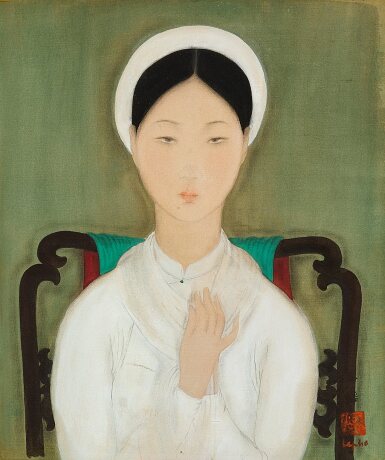Modern & Contemporary Auction
Modern & Contemporary Auction

Property of an Important Private American Collection | 美國重要私人收藏
Le Pho
Le Pho 黎譜 | Vietnamese lady 越南女士
Auction Closed
August 28, 09:27 AM GMT
Estimate
620,000 - 1,000,000 SGD
Lot Details
Description
Property from an Important Private American Collection
Le Pho
1907 - 2001
Vietnamese lady
ink and gouache on silk
signed Le Pho, painted with the artist's seal (lower right)
painted circa 1938
28.5 by 23.5 cm; 11 ¼ by 9 ¼ in.
------------------------------------
美國重要私人收藏
黎譜
1907 - 2001年
越南女士
水墨粉墨絹本
款識
黎譜 Le Pho(右下)
約1938年作
28.5 x 23.5 cm; 11 ¼ x 9 ¼ in.
Private Collection, USA (acquired directly from: Christie's Singapore, 28 September 1997, Lot 733)
Private Collection, USA(acquired directly from: Christie's Hong Kong, 26 November 2017, Lot 408)
Important Private American Collection (acquired directly from the sale above)
----------------------------
美國私人收藏(直接購自:新加坡,佳士得,1997年9月28日,拍品編號733)
美國私人收藏(售於:香港,佳士得,2017年11月26日,拍品編號408)
美國重要私人收藏(直接購自上述拍賣)
Scheveningen, The Netherlands, VSB Circustheater, De schilderkunst van Vietnam, 1 November - 30 November 1997, illustrated in the catalogue, page 4
----------------------------
荷蘭 席凡寧根 VSB 劇場 〈越南繪畫藝術〉1997年11月1-30日,展覽圖錄彩圖,4頁
Exquisitely painted and exceptionally rare, Le Pho’s Vietnamese Lady epitomizes his unparalleled technical mastery in handling silk as a medium. Featuring a young lady garbed in a white ao dai, gazing towards the viewer, the present lot showcases Le Pho’s ability to articulate the beauty of feminine mystique in a delicate manner. Painted in 1938, Vietnamese Lady is an early work hailing from a crucial period in the artist’s oeuvre.
A classically trained painter who was one of the first graduates of the École des Beaux-Arts de l’Indochine in Hanoi, Le Pho received the highbrow tutelage of prominent French artists Victor Tardieu and Joseph Inguimberty. Together with Mai Trung Thu, Vu Cao Dam and Nguyen Phan Chanh, Le Pho was part of the pioneering wave of modern artists who formed a new creative identity that diverged from the more decorative indices of traditional crafts. Synthesizing their training in French aesthetics with Vietnamese techniques and themes, these artists developed fresh approaches and paved a new direction in their country’s art history.
Le Pho was born in 1907 to the Viceroy of Tonkin during the reign of Emperor Ham Nghi. Le Pho quickly garnered popularity for his charming vignettes of domestic life rendered in a truly distinct style. In 1932, he was granted a scholarship to study at the École des Beaux-Arts in Paris, where he was able to witness the masterworks of French artistic techniques first-hand. The artist’s idyllic depictions of life have come to represent a window into Vietnam’s days of yore from the early 19th century to the early forties, a period that remained untouched by foreign colonialization or the local infighting brought on by opposing political agendas. In 1937 Le Pho left Vietnam amidst the outbreak of war and developed a career in Paris, remaining in Europe for the rest of his life.
Vietnamese lady was painted one year after his migration to Paris, when his budding career was on the verge of blossoming. In France, Le Pho found himself in the focal point of the art world, where many aspiring creatives flocked to revel in cultural freedom. Along with many foreign and local artists, he found himself in a sizzling melting pot of culture in a place brimming with opportunity. In 1938, the same year as this work, he held first one-man show, which served as his first step towards a successful painting career in Europe. Thereafter, he held exhibitions in in Algiers (1941), Paris (1945), Brussels (1948), San Francisco (1962), and New York (1963) and his oeuvre traversed geographical boundaries - a testament to his international influence. Le Pho quickly became the embodiment of the voice of the Vietnamese diaspora.
The present lot offers a close glimpse into a private moment: the picture plane is dominated by the female figure, whose features are delicate, and countenance unfettered. She sits upright and poised on a traditional wooden chair, as she faces the viewer. Le Pho’s consummate mastery of silk painting is evident in this sublime work. He uses a subtle, diaphanous colour palette that complements the delicate nature of silk, lending the painting an ethereal quality. Le Pho’s delicate brushstrokes and the use of solid colours recall the tenets of traditional Chinese ink paintings. A work of timeless beauty, Vietnamese Lady renders a window into the idyllic existence of the Vietnamese elite and the rich history of Vietnam’s treasured past.
黎譜的《越南女子》畫工精細,展示了藝術家駕馭纖巧絹面的技術,實為珍罕之作。畫中女子身穿白色越南長襖(奧黛),雙眸直視觀眾,此作體現黎譜巧用細膩方式表達女性神秘美態的過人能力。《越南女子》繪於1938年,正值黎譜創作生涯早段的關鐽時期。
黎譜曾受古典油畫訓練,是河內中南半島美術學院的首批畢業生,師承著名法國藝術家維克多・塔迪歐及約瑟夫・恩桂波提。他與枚中栨、武高談和阮潘正同為越南的現代藝術先鋒,他們一反當地傳統工藝以裝飾為主的概念,開拓出煥然一新的藝術風氣。他們既受法國美學薰陶,同時在作品中融合越南傳統的繪畫技法和主題,為越南藝術發展鋪墊新方向。
黎譜於1907年出生於咸宜帝治下的東京保護國,為北圻總督之子。他擅於描繪家庭生活中美好溫馨的小片段,其畫風別具一格,作品迅速大受歡迎。1932年,他獲頒發獎學金,前往巴黎美術學院深造,得以親眼欣賞法國藝術巨匠技法的精髓。藝術家筆下恬靜得仿如田園牧歌的生活,就像讓觀眾窺見昔日越南的一扇窗,一睹十九世紀早期至二十世紀四十年代初越南未經外來殖民、未因政治立場衝突而飽受內戰摧殘的樣貌。1937年越南抗日戰爭爆發,黎譜離開越南,移居巴黎發展事業,在歐洲渡過餘生。
《越南女子》是黎譜移居巴黎一年後繪畫的作品,時值其藝術事業的萌芽階段。他身處於藝壇的中心點法國,世界各地胸懷大志的創作人蜂湧而至,陶醉於當地的文化自由。他像許多外國和本地藝術家一樣,置身於熾熱的文化大熔爐中,到處充滿機會。就在繪畫此作的1938年,他舉行了首場個展,是為日後在歐洲發展璀璨藝途的第一步。此後,他相繼於阿爾及爾(1941)、巴黎(1945)、布魯塞爾(1948)、舊金山(1962)、紐約(1963)等地舉辦展覽,作品跨越遼闊地域,足證他在國際甚有影響力,他也很快成為越南僑民的代表聲音。
此作讓觀眾近距離一瞥一位女子恬靜安坐的私人時刻:她佔據畫面大部分空間,五官精緻,神情從容,直面觀眾,筆挺地坐在傳統木椅上。黎譜在絲絹作畫的技藝非凡出眾,在此幅秀麗的肖像中可見一斑。他運用的色彩淡雅朦朧,與纖巧精細的畫絹相得益彰,為畫作平添空靈之感。其細膩的筆觸和純實的用色,令人聯想到中國水墨畫。《越南女子》展現永恒不朽的美,為觀眾開啟探索之窗,一瞥越南上流社會生活的樸質詩意,了解當地豐富複雜的珍貴歷史。
